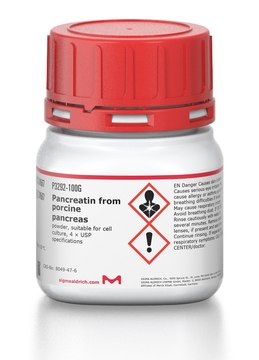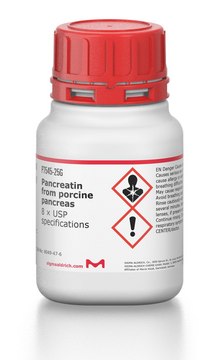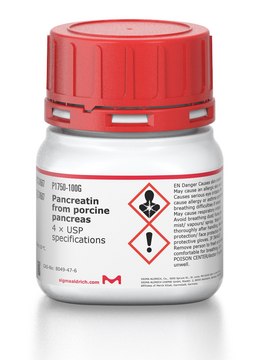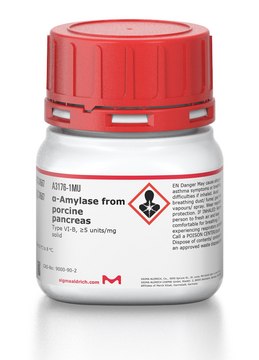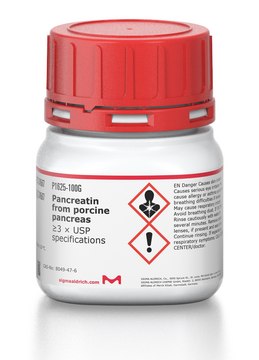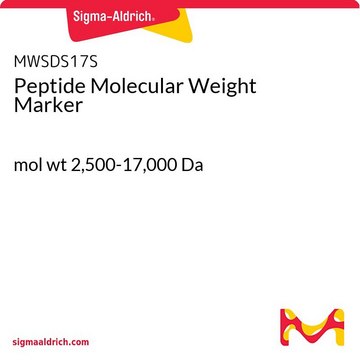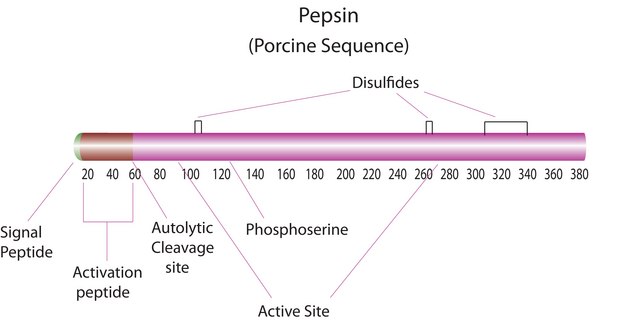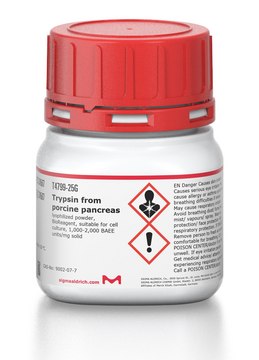Recommended Products
contains
lactose or sucrose as extender (The sucrose used might contain up to 3.25% starch.)
storage temp.
−20°C
Application
Pancreatin is a mixture of several digestive enzymes produced by the exocrine cells of the porcine pancreas. It is a broad-spectrum protease composed of amylase, trypsin, lipase, ribonuclease and protease. It is used for in vitro digestibility analysis. Pancreatin has been used to test the sensitivities of cellulolytic bacteria inhibitors .
Biochem/physiol Actions
Due to the enzymatic components such as trypsin, amylase and lipase, pancreatin hydrolyzes proteins, starch and fats. Pancreatin will convert not less than 25 times its weight of potato starch into soluble carbohydrates in 5 minutes in water at 40 °C, will digest not less than 25 times its weight of casein in 60 minutes at pH 7.5 at 40 °C and will release not less than 2 microequivalents of acid per min per mg pancreatin from olive oil at pH 9.0 at 37 °C.
Regulatory Information
新产品
Choose from one of the most recent versions:
Certificates of Analysis (COA)
Lot/Batch Number
Don't see the Right Version?
If you require a particular version, you can look up a specific certificate by the Lot or Batch number.
Already Own This Product?
Find documentation for the products that you have recently purchased in the Document Library.
J Chen et al.
Microbiology (Reading, England), 147(Pt 1), 21-30 (2001-02-13)
Competition among three species of ruminal cellulolytic bacteria - Fibrobacter succinogenes S85, Ruminococcus flavefaciens FD-1 and Ruminococcus albus 7 - was studied in the presence or absence of the non-cellulolytic ruminal bacteria Selenomonas ruminantium or Streptococcus bovis. Co-cultures were grown
Cyril W C Kendall et al.
Journal of the American College of Nutrition, 27(6), 711-718 (2009-01-22)
Postprandial hyperglycemia has been associated with increased oxidative stress and the development of diabetes, heart disease and all-cause mortality. To assess the effect of novel maize-based dietary fibers on postprandial glycemia and to assess the correlation between a rapid in
Our team of scientists has experience in all areas of research including Life Science, Material Science, Chemical Synthesis, Chromatography, Analytical and many others.
Contact Technical Service